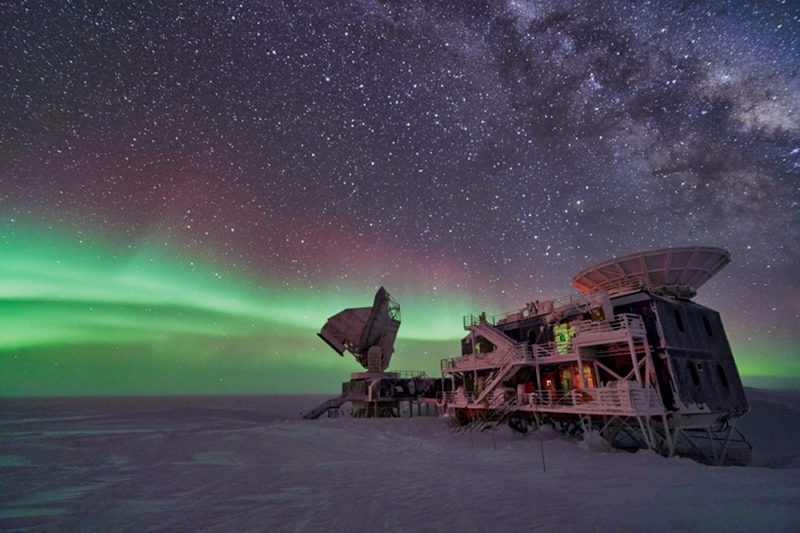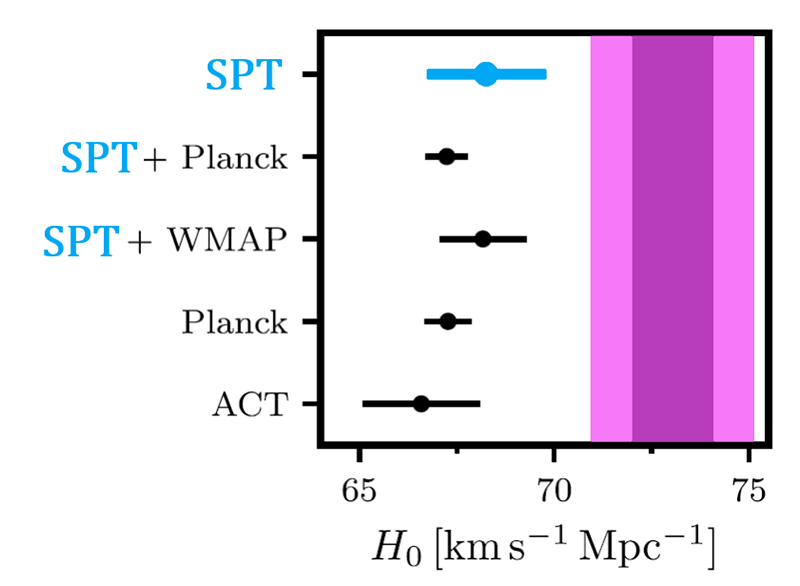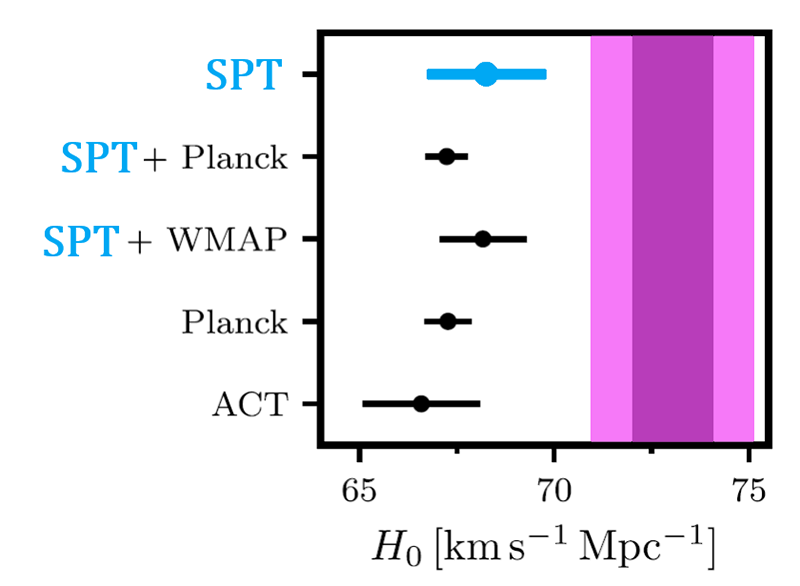Precision Cosmology with a Ground-Based Telescope
One could argue that precision cosmology began a little over 50 years ago with the discovery of the cosmic microwave background (CMB), the oldest light in the Universe. Since that discovery, researchers have probed the intricate details of the CMB using a long line of ever more sensitive instruments. The current state of the art is the South Pole Telescope (SPT), which has been observing the CMB sky from Antarctica since 2007. The telescope was upgraded in 2017 with the installation of the SPT-3G receiver, which increased the number of detectors on the instrument from roughly 1500 to 16,000. Putting this increased sensitivity on display, last year the SPT-3G Collaboration released an analysis of their 2018 observation run, combining for the first time their revised data on temperature and polarization fluctuations [1]. Using this analysis, the researchers estimated several cosmological parameters, recovering values in agreement with previous CMB experiments and thus adding more weight to certain tensions in cosmology. The results have put a spotlight on the strength of CMB physics and indicate where the next generation of instruments might take cosmology.
The CMB originated from the epoch when the Universe became transparent to light, about 380,000 years after the big bang. If the Universe’s age were scaled to that of an 80-year-old person, the CMB appeared about 19 hours after that person’s birth. Physicists Arno Penzias and Robert Wilson were the first to detect the CMB in 1965, providing strong evidence in support of the big bang theory [2]. In 1992, the Cosmic Background Explorer (COBE) satellite detected temperature fluctuations in the CMB, confirming the presence of primordial density fluctuations as predicted by inflationary theories that assume a rapid expansion in the earliest moments of the Universe [3]. The COBE measurements paved the way to the standard cosmological model based on Einstein’s general theory of relativity. This model makes a number of predictions, such as the level of clustering in galaxies, which can be compared to astronomical data to constrain the model’s parameters.
Astrophysicists have continued to mine the CMB for information using ground-based and balloon-borne experiments (such as Boomerang, Maxima, and Degree Angular Scale Interferometer, or DASI) as well as space-based missions (NASA’s Wilkinson Microwave Anisotropy Probe, or WMAP, and ESA’s Planck satellite [4]). Besides the temperature fluctuations, researchers have identified small-scale fluctuations in the polarization of the CMB light, which may contain information about the inflation epoch through the so-called B-mode polarization.
Over the past few decades, CMB observatories have been among the most important tools for probing the origin and dynamics of the Universe. Recent technological advancements, such as superconducting detectors and cryogenic systems, have allowed scientists to improve the capabilities of ground-based CMB observatories, making them complementary to space-based observations as well as giving them some specific advantages. The SPT has benefited from this technological development while also having the advantage of a South Pole location (atmospheric stability, low atmospheric absorption, long periods of darkness, and isolation from radio frequency interference), which offers high signal-to-noise observations. As such, the SPT is currently one of the most powerful CMB observatories in operation, along with the Atacama Cosmology Telescope in Chile.
The SPT has a very high angular resolution (being a 10-m telescope), allowing it to capture small-scale fluctuations in the CMB temperature and polarization maps. Researchers typically convert these fluctuations into a power spectrum, which gives the average amount of fluctuations for different angular moments, or “multipoles.” Small multipoles correspond to large angular separations (several degrees), whereas large multipoles relate to small separations (arcminute scale). The SPT can measure fluctuations with angular separations starting at 14.4 arcminutes and going down to 3.6 arcminutes, which correspond to multipoles between 750 and 3000. By comparison, the Planck satellite measured the power spectrum over the multipole range of 2 to 2500, implying that the SPT provides complementary information to space-borne instruments. In particular, the high angular multipole data from SPT observations can be used to test some inflationary scenarios and some alternative early-Universe scenarios, both of which generate features in the power spectrum.
In addition, the SPT operates at millimeter wavelengths (3.3, 2.0, and 1.4 mm), which makes it well suited for studying the Sunyaev-Zel'dovich effect—a spectral distortion caused by scattering of CMB photons off hot gas in the middle of galaxy clusters.
With all these special capabilities, the SPT provides an independent measurement of several key cosmological parameters. In the latest data analysis [1], the collaboration combined their CMB temperature and polarization measurements to put constraints on parameters such as the current cosmic expansion rate (or the Hubble constant) and other parameters that characterize the spatial distribution of galaxies. In their estimates, the researchers assumed the standard model of cosmology, but they also explored some extensions of that model that allow variations in the effective number of neutrino species, in the primordial helium abundance, and in the level of gravitational lensing.
To ensure that their analysis was reliable, the collaboration performed various internal consistency tests across the telescope’s different wavelength channels, and they blinded some of their data pipeline to avoid confirmation bias.
The SPT results address one of the most intriguing puzzles facing cosmology today: the so-called Hubble tension (see Synopsis: Tension for a Hubble-Tension Solution). The direct measurement of the Hubble constant from Cepheids (nearby pulsating stars) and supernovae [5] provides a significantly higher value of the Hubble constant in comparison with the estimated value of the Hubble constant from Planck’s CMB observations [4]. One possible way to resolve the tension is to introduce new physics, which may appear as some unknown systematics in the data [6]. Searching for systematics is challenging, in particular, because it is difficult to look for “unknown unknowns.” Hence, having independent observations and tests of their consistencies can be crucially important.
Results from the SPT show clear consistency in the estimation of the Hubble constant and other cosmological parameters with Planck measurements. This agreement between different instruments provides further confidence in CMB observations and in the way we understand them. The collaboration also made parameter estimations using a combination of their data and WMAP’s low-multipole power spectrum measurements. The precision of this combined analysis was weaker yet comparable to that of Planck, implying that ground-based CMB telescopes such as the SPT and ACT can have strong constraining power over cosmological models while not suffering from the high risk and cost of space missions.
The success of the SPT-3G Collaboration and the high-level technology used to measure temperature and polarization of the CMB supports the importance of near-future ground-based telescopes such as the Simons Observatory [7] and CMB-S4 [8]. These ground-based projects should further help to constrain the key cosmological parameters, and it wouldn’t be surprising if one of them is the first to detect the inflation-related B-mode polarization, beating out the next generation of space-based CMB missions such as LiteBIRD.
References
- L. Balkenhol et al. (SPT-3G Collaboration), “Measurement of the CMB temperature power spectrum and constraints on cosmology from the SPT-3G 2018 TT, TE, and EE dataset,” Phys. Rev. D 108, 023510 (2023).
- A. A. Penzias and R. W. Wilson, “A measurement of excess antenna temperature at 4080 Mc/s.,” Astrophys. J. 142, 419 (1965).
- G. F. Smoot et al., “Structure in the COBE differential microwave radiometer first-year maps,” Astrophys. J. Lett. 396, L1 (1992).
- N. Aghanim et al. (Planck Collaboration), “Planck 2018 results. VI. Cosmological parameters,” Astron. Astrophys. 641, A6 (2020).
- A. G. Riess et al., “A comprehensive measurement of the local value of the Hubble constant with 1 km s−1 Mpc−1 uncertainty from the Hubble Space Telescope and the SH0ES team,” Astrophys. J. Lett. 934, L7 (2022).
- R. E. Keeley and A. Shafieloo, “Ruling out new physics at low redshift as a solution to the H0 Tension,” Phys. Rev. Lett. 131, 111002 (2023).
- P. Ade et al., “The Simons Observatory: Science goals and forecasts,” J. Cosmol. Astropart. Phys. 2019, 056 (2019).
- K. Abazajian et al., “CMB-S4 science case, reference design, and project plan,” arXiv:arxiv: 1907.04473.







